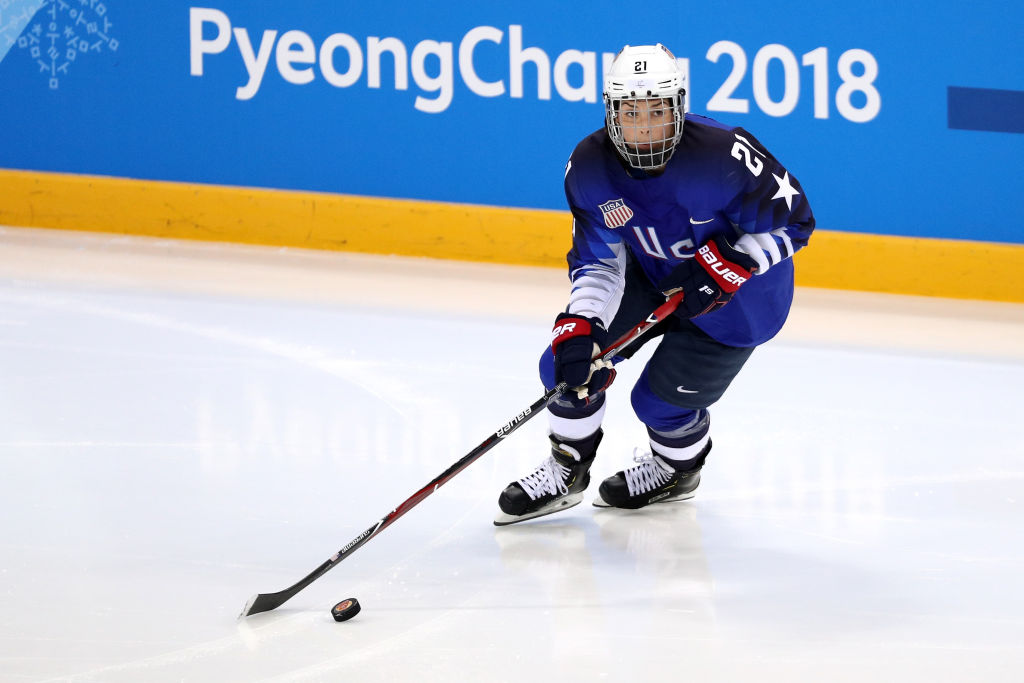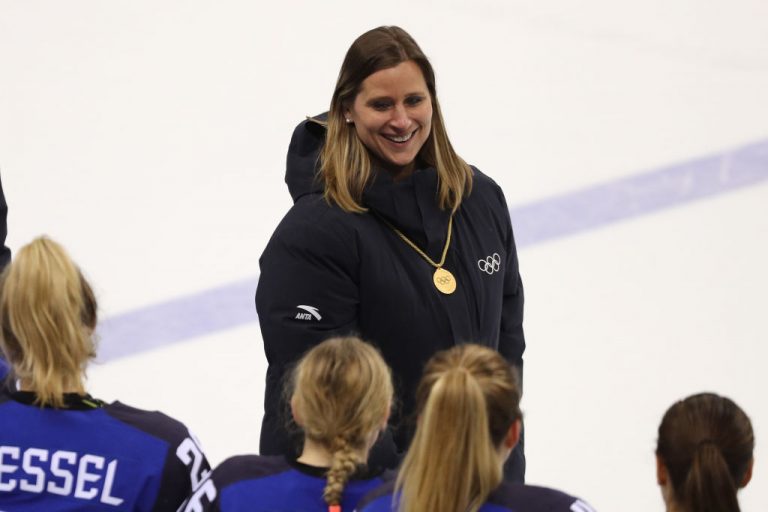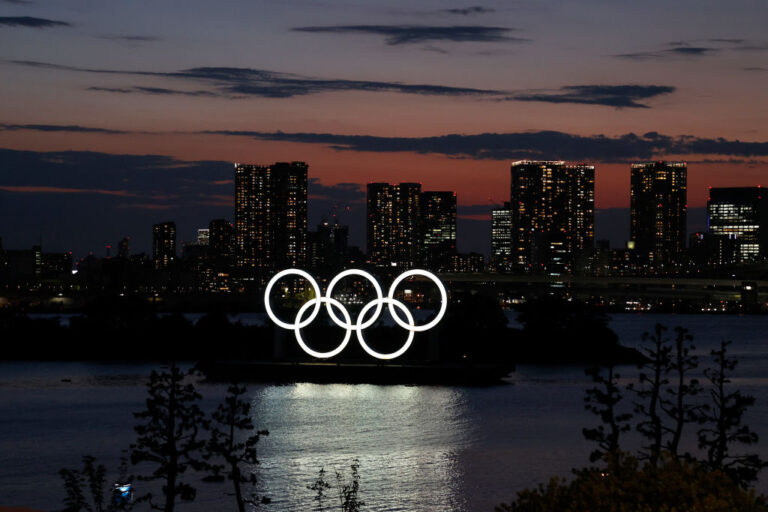Can the Beijing Winter Olympics Jump-Start Women’s Pro Hockey in North America?
Why this matters
Hurt by the pandemic and canceled world championships and still struggling to establish a viable North American league featuring all of the sport's top talent, women's professional hockey is at a crossroads – and hoping to gain much-needed momentum from the Winter Olympics in Beijing.
When the U.S. forward Jocelyne Lamoureux-Davidson scored the dazzling 3-2 shootout winner in the 2018 Winter Olympic gold medal game against archrival Canada, it seemed like the stage was set for women’s hockey to break into the mainstream in the United States.
Featuring equal parts skill and intensity, the game was a perfect advertisement for the sport. Lamoureux-Davidson’s clever winning move to fool Canadian goalie Shannon Szabados even came with a perky pop culture twist. It was called “Oops! I Did It Again” in a tribute to the Britney Spears hit.
“When we have this border battle with Canada, it’s a great game to be a part of,” said U.S. forward Hilary Knight, the all-time leading goal-scorer in International Ice Hockey Federation (IIHF) Women’s World Championship history. “It really gets your blood flowing, and it’s something that a lot of us live for.”
As the 2022 Winter Games begin in Beijing, however, the visibility and valuation of women’s professional hockey continues to lag. In North America, elite players remain far from being household names like National Hockey League superstars Connor McDavid or Sidney Crosby. And the sport has yet to attract much more than a hardcore, cult-level fan following, even though close to 210,000 women play hockey worldwide, mostly in Canada (101,879) and the U.S. (84,102).
Following their 2018 triumph in South Korea, Team USA racked up a string of network TV appearances. Highlights included Knight’s cameo with comedian Leslie Jones on Saturday Night Live and goalie Maddie Rooney’s confession on The Tonight Show that she was eager to meet singer Justin Bieber. Excitement around the sport appeared to be cresting.
However, the same team’s victory tour of NHL arenas was brief. Individual sponsorships and endorsements for players didn’t spike significantly. A widely anticipated NHL-sponsored women’s league never came to fruition.
The projected post-2018 growth of women’s hockey has been further undercut by economic shockwaves, league collapses, tournament cancellations, internecine conflicts among the sport’s elite players and decision-makers, and, of course, the global COVID-19 pandemic.
All of this has left players – who are not demanding to be millionaires but do want to maximize their performance without having to constantly figure out how to pay their bills – feeling frustrated. “We want more games, more opportunity,” said U.S. captain Kendall Coyne Schofield. “We train every day. Ask an NHLer if he could train every day in order to play potentially 10 games a year. I think he’d say no. We want more.”
It also raises a question: Can the Beijing Olympics, which run Feb. 3-17, give the sport a much-needed boost?
There is no bigger platform than the Olympics to grow a sport. If the U.S. repeats as champion for the first time ever (its only previous gold came at the inaugural 1998 tournament in Nagano, Japan), the resulting publicity could yield major new investments in the sport, from ramped-up college hockey programming to increased television coverage of pro women’s hockey.
There also are potential silver linings if a U.S. victory doesn’t happen, ones that go beyond a traditional post-Olympic uptick in young girls registering to play hockey. If Canada wins gold for the first time since 2014, it will be a huge boost for the country that invented hockey.
The Canadians, who had lost five straight Women’s World Championship finals to the U.S. dating to 2013, gained confidence from rallying to beat the U.S. 3-2 in overtime on captain Marie-Philip Poulin’s goal at the 2021 Women’s World Championship in Calgary in August.
Meanwhile, if a different national team triumphs in Beijing – such as usual bronze medalist Finland, which came within a hair’s-breadth of defeating the U.S. in the 2019 Women’s World Championship final – the global perception of the sport could dramatically change.
International women’s hockey is often seen as a two-horse race between the North American archrivals. Only at the 2006 Turin Winter Games did Sweden – with a shocking 3-2 semi-final shootout win over the U.S. – break the cycle of all-North American Olympic finals. The Swedes fell 4-1 to Canada in the gold medal game.
If the Finns – or an even bigger dark horse like the Swiss or the Russians – can pull off a gold medal upset in Beijing, it would confer a newfound legitimacy on women’s hockey and increase the intrigue heading into future international tournaments.
“I think the game will definitely take that next step,” said Canada’s Meghan Agosta, who was the MVP of the 2010 Vancouver Olympics. “It’s just a matter of time. We just need everybody to believe in it and take that chance. If you look on the men’s side, it took other countries a while to catch up to Canada and the U.S., and now look at the competition in the Olympics and Worlds. Truthfully, I think that’s what it’s been like on the women’s side, but now these other countries are right behind us. You can’t take a day off.”
Women’s hockey also needs a successful Olympic showcase because of the pandemic’s complex and devastating impact. In March 2020, the IIHF World Championship scheduled for Nova Scotia was canceled. The proposed May 2021 Women’s Worlds in the same two cities was canceled at the last-minute due to provincial health restrictions and was finally played in only Calgary in August.
Meanwhile, the 2021 and 2022 under-18 Women’s World Championships were both canceled due to COVID-19 concerns. (However, after a public outcry, it’s likely the 2022 edition will be rescheduled for the summer.)
All of this has made it harder for people to see women’s hockey. TSN sports broadcaster Kenzie Lalonde, a former Canadian university hockey player, says that lack of visibility remains a major problem.
“When I look back to people I actually looked up to, it was my hockey camp counselors, because the women’s game only came around at the Olympics,” Lalonde said. “And then the Olympics ended, and you didn’t really know where you could find these incredible female hockey players or what they were doing.”
Whatever the outcome in Beijing, what happens next will be far more important for the sport. Top U.S. and Canadian players are members of the Professional Women’s Hockey Players Association (PWHPA), which has one key goal.
“We all want a sustainable pro league, one where we can just focus on hockey and make it our profession,” said Canada’s Jamie Lee Rattray, who scored three of her four 2021 Women’s Worlds goals against the Americans. “We’ve already proven enough times that women’s hockey has a viable market. Our game is in such a good place. The talent is higher than ever. So I honestly think that if we use the momentum after the Olympics, we’re going to have a sustainable league here.”
So far, that goal has proved elusive. The PWHPA formed in 2019 after the sudden collapse of the Canadian Women’s Hockey League (CWHL). PWHPA members in both Canada and the U.S. vowed not to play anymore in the U.S.-based National Women’s Hockey League (NWHL), notorious for slashing wages and providing sub-par playing conditions.
In September 2021, the NWHL rebranded gender-neutrally as the Premier Hockey Federation (PHF). But the six-team, Eastern U.S.-based PHF was unable to win over the PWHPA – whose non-Beijing-bound members continued to schedule exhibition games, including against their peers on the centralized U.S. and Canadian Olympian teams – with its average annual player salary of $15,000 and lack of full health benefits.
Even after the PHF’s newly minted deal to have all 60 regular-season games and the Isobel Cup playoffs streamed on ESPN+, PWHPA defectors like the Boston Pride’s Kali Flanagan – a 2018 Olympic gold medalist – have been the exception rather than the rule.
In January, the PHF announced that it would increase its per-team salary cap of $300,000 to $750,000 for 2022-23, facilitating average salaries of $37,500 and full health benefits. That came as part of a reported $25 million investment by the league board of governors. The PHF also plans to add a Montreal expansion team and another U.S. franchise.
It remains to be seen if this could lay the groundwork for a true partnership between the PWHPA and PHF. The PHF is still struggling with internal dissent, including the hiring and firing of Alex Sinatra as the executive director of its players’ association within just 25 days in January.
Meanwhile, it’s unlikely that the NHL will step up to sponsor a WNHL modeled on the NBA’s relationship with the WNBA. The men’s league – already a reluctant partner with pro women’s hockey – pulled out of Beijing participation in December after COVID-19 protocols forced the cancellation of dozens of league games.
Finnish star Michelle Karvinen brings a distinctive perspective on the ever-fluctuating world of North American women’s pro hockey. The 31-year-old forward, who tied for the 2014 Olympic points lead, last played in North America with the University of North Dakota (2011-14). In the past three seasons, Karvinen has suited up professionally everywhere from Sweden to Switzerland to Russia in search of new challenges and better playing conditions.
“I think creating one league [in North America] would be better, because it seems, at least from Europe’s perspective, a lot of things are changing every year,” Karvinen said.
Rumors surfaced in late January that the PWHPA will look to start a new league that will kick off in the fall. However, an official announcement is not expected until after the Winter Games.
For now, women’s professional hockey is caught in a chicken-and-egg situation that nearly every women’s pro sports league has faced in the U.S.: It needs sizable audiences on a regular basis to attract the financial backing and infrastructure that will take the sport to the next level, but it is struggling to attract those audiences without sufficient financial resources.
As a showcase for the sport’s skill, speed, and excitement, the Beijing Olympics offer a relatively rare opportunity to escape that conundrum. With the world watching, much more than medals will be at stake.




